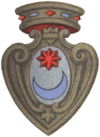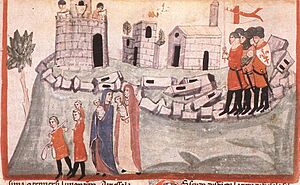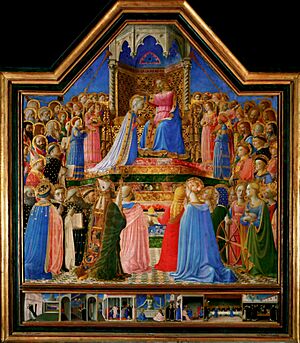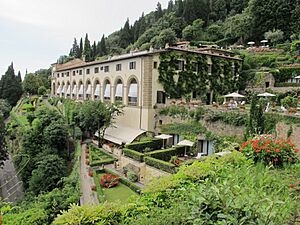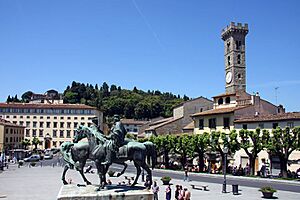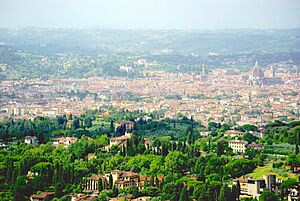Fiesole facts for kids
Quick facts for kids
Fiesole
|
||
|---|---|---|
| Città di Fiesole | ||

Aerial view of Piazza Mino, the main square of Fiesole
|
||
|
||
| Country | Italy | |
| Region | Tuscany | |
| Frazioni | Anchetta, Caldine, Compiobbi, Ellera, Girone, Pian del Mugnone, Pian di San Bartolo, San Domenico | |
| Area | ||
| • Total | 42 km2 (16 sq mi) | |
| Elevation | 295 m (968 ft) | |
| Population | ||
| • Total | 14,075 | |
| • Density | 335/km2 (868/sq mi) | |
| Demonym(s) | Fiesolani | |
| Time zone | UTC+1 (CET) | |
| • Summer (DST) | UTC+2 (CEST) | |
| Postal code |
50014
|
|
| Dialing code | 055 | |
| Patron saint | Romulus of Fiesole | |
| Saint day | 6 July | |
Fiesole (pronounced FYEH-zoh-leh) is a charming town and comune (which is like a municipality or district) in the Metropolitan City of Florence. It's located in the Italian region of Tuscany. You can find it on a beautiful hill overlooking Florence, about 5 kilometers (3 miles) northeast of the city. Fiesole has amazing buildings that date back to ancient Etruscan and Roman times.
The city was founded in the seventh century BC. Its original name was Vipsul. It quickly became one of the most important early cities of the Etruscan civilization. Since the 1300s, Fiesole has been a popular escape for wealthy people from Florence. Even today, it's known for its beautiful and expensive homes, along with centuries-old villas and their fancy gardens. Many people consider Fiesole to be the richest area near Florence. In fact, in 2016, it had the highest average family income in all of Tuscany!
Fiesole is also a place for advanced learning. The main campus of the European University Institute is located here. It uses several historic buildings, including the Badia Fiesolana and the Villa Schifanoia. Plus, American universities like Harvard, Georgetown, and Saint Mary's of Minnesota all have campuses in Fiesole.
Contents
Exploring Fiesole's Past
Fiesole, known as Faesulae in Latin and Viesul or Vipsul in Etruscan, was likely founded around the ninth century BC. It was an important member of the Etruscan confederacy, a group of powerful Etruscan cities. You can still see parts of its ancient walls and old buildings today. There's also an archaeological museum in town that shows off artifacts and information from these early times.
The first time Fiesole was mentioned in writing was in 283 BC. At that time, the Etruscan town, called Faesulae, was conquered by the Romans. In Roman times, it was famous for a school where people learned to predict the future, called augurs. Every year, twelve young men from Rome would come here to study this art.
The old town was destroyed around 80 BC. This might have happened during a war called the Social War, or by a Roman general named Sulla. Sulla destroyed it because Fiesole supported his enemies in Rome. Later, Sulla settled his retired soldiers there. These soldiers then supported another Roman leader named Catilina.
Roman Theatre and Discoveries
Below the main cathedral, you can find the Roman theatre. It has 19 rows of stone seats and is about 34 meters (37 yards) wide. It has been partly rebuilt, so you can get a good idea of what it looked like. Above the theatre is an old wall made of rough stones. Below it are some remains of Roman baths, including five curved concrete structures. In 1829, more than 1,000 silver Roman coins, all made before 63 BC, were found in Fiesole. A small museum in town displays the items found during the theatre's excavation.
Fiesole in the Middle Ages
Fiesole was the site of an important battle in 406 AD. A Roman general named Stilicho won a great victory here against Germanic tribes like the Vandals and Suebi, led by Radagaisus. During the Gothic War (536–553), the town was attacked many times. In 539, a Byzantine general named Justin captured Fiesole and destroyed its defenses.
For several centuries in the early Middle Ages, Fiesole was an independent town. It was just as powerful as Florence, which was located in the valley below. This led to many wars between the two cities. In 1010 and 1025, Florence attacked Fiesole. Finally, Florence conquered Fiesole in 1125. After this, Fiesole's most important families had to move to Florence. The famous poet Dante even mentioned this rivalry in his Divine Comedy, calling the people of Fiesole "the beasts of Fiesole."
Fiesole's Renaissance Connection
By the 1300s, wealthy Florentines built country villas in Fiesole. One of these villas is the setting for the famous book Decameron by Giovanni Boccaccio. Boccaccio also wrote a poem called Il Ninfale fiesolano, which tells a mythological story about how Fiesole began.
It's also known that the famous artist and scientist Leonardo da Vinci tried out his early flying models on the hills of Fiesole.
Important Places to See
Fiesole has many interesting historical sites and buildings:
- Ancient Walls: You can still see parts of the old Etruscan walls.
- Roman Remains: Explore the ruins of the Roman baths and the Roman theatre.
- Palazzo Pretorio: This is also known as the Town Hall (Palazzo Comunale). It's a beautiful building from the 1300s.
- Cathedral of Fiesole: This main church, called Il Duomo, holds the shrine of St. Romulus, who is believed to be the first Bishop of Fiesole. It also has an altarpiece painted by Pietro Perugino.
- Badia Fiesolana: This was once the old cathedral of St. Romulus, built in 1028. It later became a Benedictine abbey. It used to have a very valuable library.
- Episcopal Palace: This palace has a room where the Carmelite bishop St. Andrew Corsini lived and died.
- Church of Santa Maria Primerana: This small church in the cathedral square was built in 996. It has a beautiful facade from the late 1500s. Inside, you can see a 13th-century painting of the Madonna with Child.
- Church of S. Alessandro: This church contains the shrine of St. Alexander, another bishop and martyr.
- Monastery of San Francesco: Located at the top of the hill, this monastery has the cells where St. Bernardine of Siena and seven other important Franciscans lived.
- Church of San Girolamo: This church was home to Carlo dei Conti Guidi, who founded the Hieronymites of Fiesole in 1360.
- Convent of San Domenico: This was the first home for new members of the Dominican order, including famous figures like Fra Angelico and St. Antoninus of Florence.
- Fontanelle: A villa near San Domenico where St. Aloysius stayed during hot summer months.
- Villa I Tatti: A campus of Harvard University.
- Villa Medici: A historic villa with beautiful gardens.
- Villa Le Balze: A campus of Georgetown University.
- Villa Palmieri: Another famous villa in Fiesole.
- Villa Schifanoia: A historic villa used by the European University Institute.
- Villa Sparta: This was once the home of the Greek royal family when they were in exile.
- Fonte Lucente: A place where a crucifix is believed to be miraculous.
- Castello di Vincigliata: A beautiful castle.
- Diocesan Seminary of Fiesole: A school for priests.
Nearby Attractions
- Monte Senario: This is where the Servite Order began. Its seven holy founders lived a simple life here.
- S. Martino di Mensola: This church holds the body of St. Andrew, an Irish saint, which is said to be perfectly preserved.
- Monte Ceceri: This hill has a monument to Leonardo da Vinci's attempt at flight.
Famous People from Fiesole
Many notable people have lived in or been connected to Fiesole:
- Angelo Maria Bandini: An Italian writer.
- Bernard Berenson: An American art historian.
- Giovanni Boccaccio: A famous Renaissance writer, author of the Decameron.
- Arnold Böcklin: A Swiss painter.
- St. Andrew Corsini: A Carmelite friar and Bishop of Fiesole.
- Alexandre Dumas: A French writer.
- Bridget of Fiesole: A 9th-century Irish nun.
- Mino da Fiesole: A Florentine sculptor and painter from the 1400s.
- Helen of Greece and Denmark: Queen mother of Romania, honored for helping save Jews during World War II.
- Hermann Hesse: A German-Swiss writer, who featured Fiesole in his novel Peter Camenzind.
- Paul of Greece: A King of Greece.
- Paul Klee: A German painter.
- Francesco Landini: A composer, singer, and musician from the 1300s.
- Paolo Litta: A composer.
- Elisabeth Mann-Borgese: A German writer.
- Lorenzo Monaco: A painter from the late 1300s and early 1400s.
- Marcel Proust: A French writer.
- Andrew the Scot: A 9th-century Irish archdeacon.
- Gertrude Stein and Alice B. Toklas: American writers who spent summers in Fiesole.
- Roger Verity: An Anglo-Italian entomologist (someone who studies insects).
- Frank Lloyd Wright: A famous American architect.
- Miloš Crnjanski: A Serbian writer and poet.
Fiesole in Books
Fiesole has appeared in several famous books:
- The Decameron by Giovanni Boccaccio is set on the hills of Fiesole.
- It's featured in the novel Peter Camenzind (1904) by Hermann Hesse.
- The town is also in A Room with a View (1908) by E. M. Forster.
- It's mentioned in the travel essays Italian Hours (1909) by Henry James.
Fiesole in Modern Art
- A large wall mural in the Grossi Florentino restaurant was painted by students of Napier Waller, supervised by him.
See also
 In Spanish: Fiesole para niños
In Spanish: Fiesole para niños


